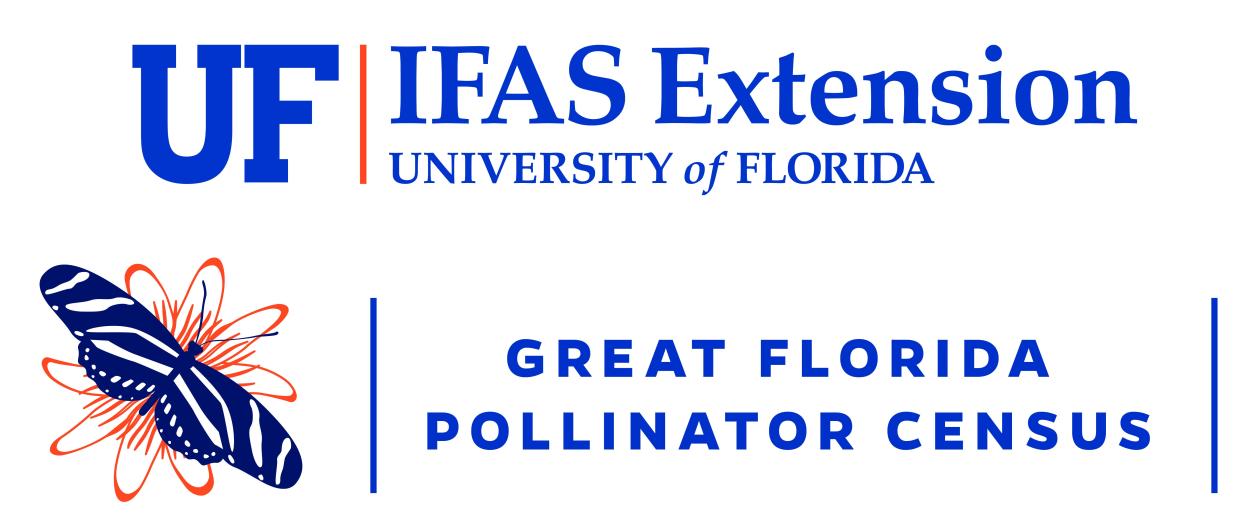The Great Florida Pollinator Count

UF/IFAS Extension Marion County is thrilled to announce that Florida has joined the Great Southeast Pollinator Census! We will be partnering with the states of Georgia, South Carolina and North Carolina in sustaining our pollinators, one count at a time. With much of Florida’s year-round tropical climate, our state can potentially sustain, if not increase, pollinator populations.
The pollinator census was created in 2019 with three primary goals: increase pollinator habitats, teach the public about the importance of insects to our ecosystems and overall livelihoods, and provide useful data to research through citizen science.
Since the start of the program, more than 12,000 people in Georgia and the Carolinas have participated in the count, and more than 2,500 pollinator habitats have been planted.
So, what, exactly, is the pollinator count? Every year for two days in August, thousands of individuals take the time to sit down for 15 minutes and observe a blooming plant in a landscape, and record the number and type of pollinators that land on that plant.
A colored insect guide is provided to the counter, along with the pollinator count sheet that includes the eight general categories of pollinating insects — carpenter bees, bumble bees, honey bees, small bees, wasps, flies, butterflies/moths and other insects.
At the end of the 15 minutes, the counter then uploads their counts to the Great Southeast Pollinator Census website. Their data is then compiled into their state’s database and allows us to see pollinator populations by county.
Thanks to the census, we have gained a better understanding of what types of plants truly attract specific pollinators. For example, red pentas are a well-known butterfly attractant plant. This is true because of the red color that butterflies are so highly attracted to, but we’ve learned that even more so than butterflies, wasps are attracted to red pentas.
Specifically, many beneficial predatory wasps, such as the Larra Wasp that will feed on mole crickets, a major pest of bahiagrass lawns. Could planting red pentas within a landscape help to biologically control this pest species? This now presents an opportunity for a research study to be conducted, which could result in less use of pesticides in our environment.
The Great Florida Pollinator Count is for anyone in Florida who wants to help our pollinators! We encourage school groups, churches, garden clubs, HOAs and many others to participate! For more information, or to learn how to participate, visit gsepc.org or follow our Facebook page at facebook.com/groups/southeastpollinatorcensus.
May to-do list
Annuals: Start incorporating plants that can withstand the summer heat, such as salvias, coreopsis, wax begonia and coleus. There are many options of coleus, and a variety of colors.
Herbs: Basil and rosemary are two heat-loving herbs that will perform great throughout the summer in central Florida.
Vegetables: Now is a great time to plant sweet potatoes, okra and sweet peas! All do well throughout the heat of summer. For more information on vegetable gardening, visit edis.ifas.ufl.edu/topic_vegetable_gardening.
Lawns: Pay attention for signs of chinch bugs in St. Augustinegrass and mole crickets in Bahiagrass. This is the time of year where folks start finding dead patches of grass. If you start seeing this, scout and look for insect pests. Remember, lawns should not be irrigated more than twice a week, and no longer than 30 to 40 minutes per irrigation event. Prevent fungal growth by not overwatering. Rain can save you a lot of water and money.
Mulch: Add 2 to 3 inches of mulch in the landscape for weed suppression and water retention during the summer. Avoid the use of cypress mulch and instead use Florida-friendly mulch options, such as pine needles, pine bark or melaleuca mulch.
Upcoming Events with UF/IFAS Extension, Marion County: 9 to 11 a.m. May 15, UF/IFAS Extension Marion County Demonstration Garden Tour. Free with registration. 2232 NE Jacksonville Road, Ocala, FL 34470. Come join us for a free educational tour of our demonstration gardens and propagation nursery. Get inspired on how you can create Florida-friendly landscapes, foodscapes, vegetable gardens, pollinator gardens and more, right here in Central Florida. Register here: tinyurl.com/yck8rxuy; June 4-Aug. 8, Summer Gardening 101 Series. $35. UF/IFAS Extension classroom, 2232 NE Jacksonville Road, Ocala, FL 34470. Join us for hot topics in horticulture this summer! Admission price includes any five classes of your choice. To see a full list of classes and to register, visit tinyurl.com/mvxpkzjw; Aug. 23-24, Great Florida Pollinator Count. Join us by participating in the first Great Florida Pollinator Count. Various parks around the county will be participating, including the UF/IFAS Extension Demonstration Gardens. You also can participate from your own property. For more information, visit gsepc.org.
— Jeremy Rhoden is the Urban and Residential Horticulture Extension Agent and Master Gardener Volunteer Coordinator at the UF/IFAS Extension Marion County. For more information, contact the office at 671-8400. The Extension Service is located at 2232 NE Jacksonville Road, Ocala, FL 34470.
This article originally appeared on The Gainesville Sun: The Great Florida Pollinator Count

